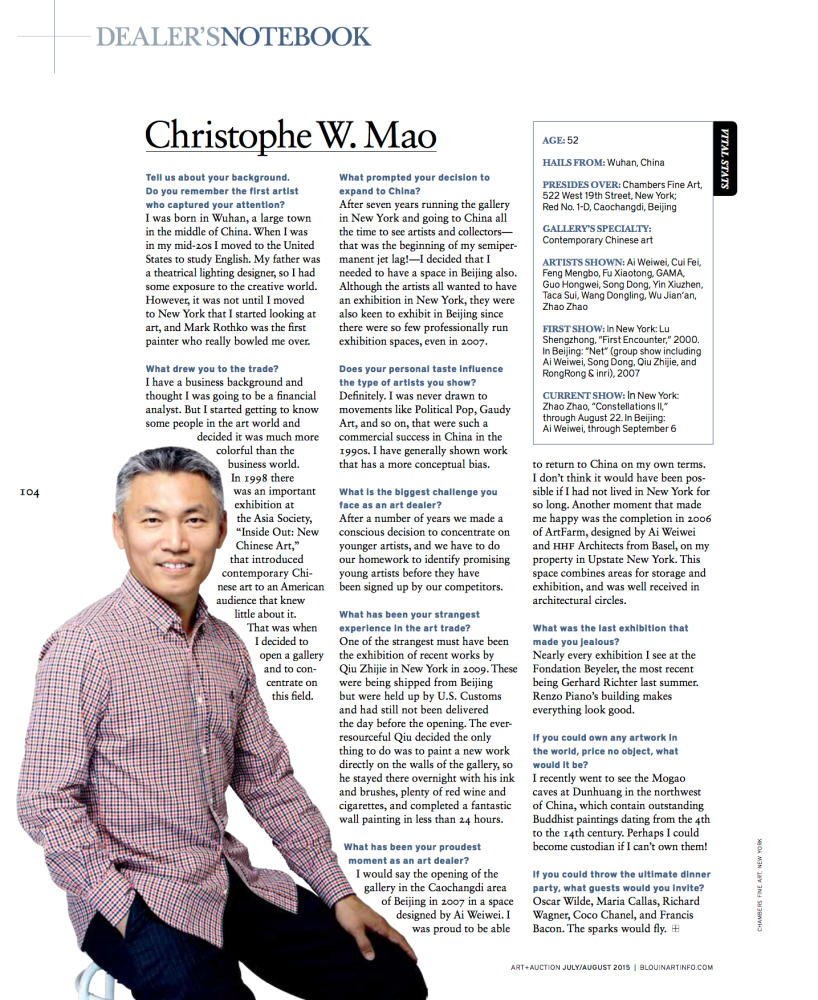
Tell us about your background. Do you remember the first artist who captured your attention?
I was born in Wuhan, a large town in the middle of China. When I was in my mid-20s I moved to the United States to study English. My father was a theatrical lighting designer, so I had some exposure to the creative world. However, it was not until I moved to New York that I started looking at art, and Mark Rothko was the first painter who really bowled me over.
What drew you to the trade?
I have a business background and thought I was going to be a nancial analyst. But I started getting to know some people in the art world and decided it was much more colorful than the business world. In 1998 there was an important exhibition at the Asia Society, “Inside Out: New Chinese Art,” that introduced contemporary Chinese art to an American audience that knew little about it. That was when I decided to open a gallery and to concentrate on this field.
What prompted your decision to expand to China?
After seven years running the gallery in New York and going to China all the time to see artists and collectors— that was the beginning of my semipermanent jet lag!—I decided that I needed to have a space in Beijing also. Although the artists all wanted to have an exhibition in New York, they were also keen to exhibit in Beijing since there were so few professionally run exhibition spaces, even in 2007.
Does your personal taste influence the type of artists you show?
Definitely. I was never drawn to movements like Political Pop, Gaudy Art, and so on, that were such a commercial success in China in the 1990s. I have generally shown work that has a more conceptual bias.
What is the biggest challenge you face as an art dealer?
After a number of years we made a conscious decision to concentrate on younger artists, and we have to do our homework to identify promising young artists before they have been signed up by our competitors.
What has been your strangest experience in the art trade?
One of the strangest must have been the exhibition of recent works by Qiu Zhijie in New York in 2009. These were being shipped from Beijing but were held up by U.S. Customs and had still not been delivered the day before the opening. The ever- resourceful Qiu decided the only thing to do was to paint a new work directly on the walls of the gallery, so he stayed there overnight with his ink and brushes, plenty of red wine and cigarettes, and completed a fantastic wall painting in less than 24 hours.
What has been your proudest moment as an art dealer?
I would say the opening of the gallery in the Caochangdi area of Beijing in 2007 in a space designed by Ai Weiwei. I was proud to be able to return to China on my own terms. I don’t think it would have been pos- sible if I had not lived in New York for so long. Another moment that made me happy was the completion in 2006 of ArtFarm, designed by Ai Weiwei and hhf Architects from Basel, on my property in Upstate New York. This space combines areas for storage and exhibition, and was well received in architectural circles.
What was the last exhibition that made you jealous?
Nearly every exhibition I see at the Fondation Beyeler, the most recent being Gerhard Richter last summer. Renzo Piano’s building makes everything look good.
If you could own any artwork in the world, price no object, what would it be?
I recently went to see the Mogao caves at Dunhuang in the northwest of China, which contain outstanding Buddhist paintings dating from the 4th to the 14th century. Perhaps I could become custodian if I can’t own them!
If you could throw the ultimate dinner party, what guests would you invite?
Oscar Wilde, Maria Callas, Richard Wagner, Coco Chanel, and Francis Bacon. The sparks would fly.